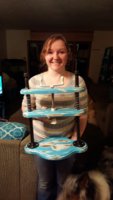- Thread starter
- #11
samssimonsays
Almost Self-Reliant
It may not have been "correct" but we aged ours in our crisper and fridge... after we waxed the ones that required aging. I tried vacuum sealing them but they got moldy anyways.... the wax, as long as you don't have air bubbles did great!
I also have a how to make cheese wax recipe
I also have a how to make cheese wax recipe

